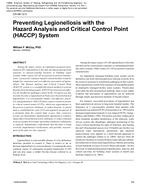Description
Among the major causes of community-acquired pneumonia (CAP), legionellosis is the only one that people get from exposure to disease-causing bacteria in building water systems. Other causes of CAP are person-to-person transmissions. A practical voluntary hazard control method would be helpful for consistent and cost-effective prevention of legionellosis. The Hazard Analysis and Critical Control Point (HACCP) system is a scientifically-based method to prevent hazards from harming people. HACCP has been proven effective for foodborne pathogen control in the US and its use has recently become a requirement in France for the prevention of legionellosis. It is conceptually simple, cost-effective, practical, and quantitative. HACCP plans connect control activities to critical control points (CCPs), which are opportunities in the process to prevent, eliminate, or reduce hazards. A control limit is established for each CCP and regularly monitored. If a deviation from the control limit occurs, then corrective actions are immediately implemented. Quantitative evidence (data) that critical limits prevent, eliminate, or reduce a hazard to an acceptable level under operating conditions (validation) is required. Independent confirmation that the plan is being correctly implemented (verification) and periodic reassessment of the plan are also required.
Units: Dual
Citation: Symposium, ASHRAE Transactions, vol. 112, pt. 1
Product Details
- Published:
- 2006
- Number of Pages:
- 8
- File Size:
- 1 file , 100 KB
- Product Code(s):
- D-27963




